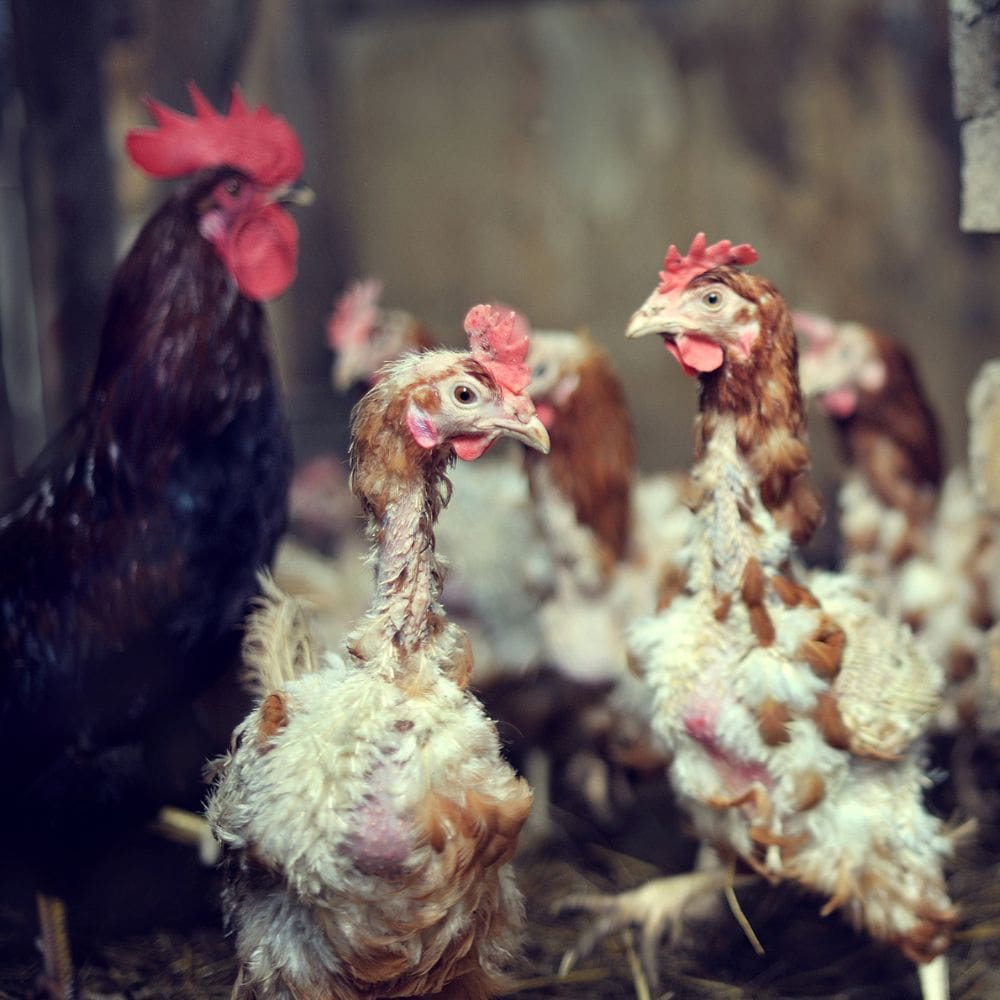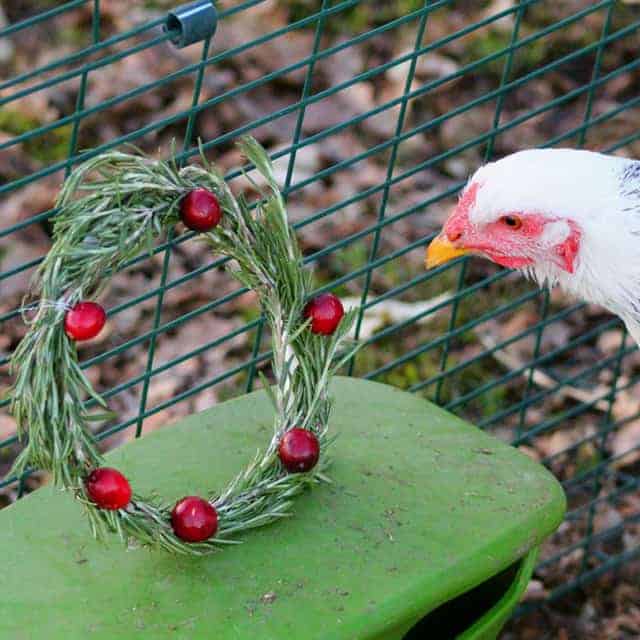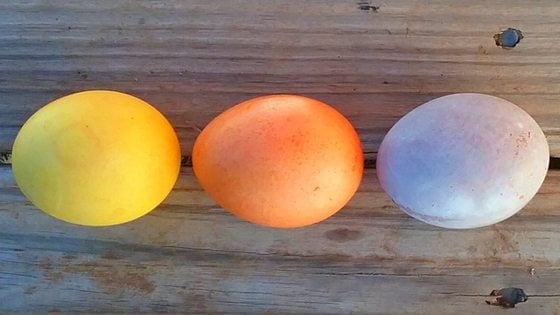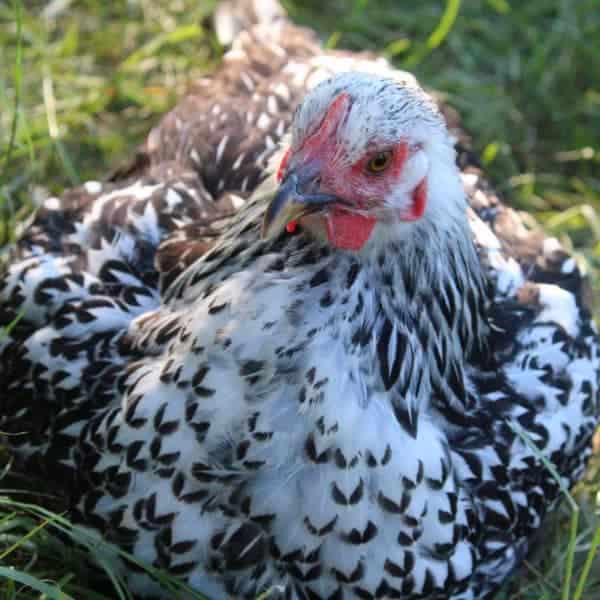Molting chickens can be stressful because, well, your flock looks naked and like they’re unhealthy.
In fact, they can look like they’ve been to hell and back. They can look scruffy, and you might worry that they’re sick. And you might even take them to the vet!
When we say “chickens molting,” you might wonder what that really means. It’s a term you see thrown around on Facebook, but it can be confusing if you’re a beginner with chickens.w
Basically, when we say “chickens molting,” we mean that your hens and roosters are losing their feathers. They shed old feathers and then grow new ones! Don’t worry the molting process is perfectly normal.

Table of Contents (Quickly Jump To Information)
When do chickens molt?
Chickens tend to molt in the late summer, early fall or even early winter when breeding season is over.
As your chickens get more and more “naked,” you’ll probably worry that your flock is cold (they might be and you’ll have to find a way to keep them warm).
You might be wondering “when do chickens molt for the first time? – it’s a typical question new owners ask. The answer is that chickens start molting typically in the winter after their first year. The timing can vary but it’s typically in the 14 to 18-month old range.
How often do chickens molt?
Usually, every year, although the severity of the molt (meaning how many feathers they’ll lose) varies from hen to hen and the year.
Your mileage will vary; while some people have chickens that look like they’ve had every feather removed, I’ve personally never had a hen lose more than a few feathers.
We live in an area where the winters are mild, so maybe that has something to do with it!
How long does molting last?
Almost universally, when I encounter a new backyard flock owner who has chickens molting, I’m asked “How long do chickens molt?” and the answer probably won’t satisfy you.
Truthfully, only your chickens know how long they’ll be molting. We’ve had it last 2 weeks and up to 6 months. Most molting seems to last 60 to 90 days, from the time the hens start to lose their feathers to completely regrowing new ones.
During this time, as your hens regrow their feathers, they’ll be more physically sensitive than normal. As the feathers start to grow, new pin feathers emerge. Touching them can hurt your chickens.
When the feathers finish growing, though, your hens won’t be so sensitive, and you can pick them up and pet them as you normally would.
You might be tempted to provide a sweater or saddle for molting chickens, but it’s best to just let nature take its course. If it’s very cold out, you can find another way to keep your flock warm.
Chickens molting or chicken mites?
When your chickens start to lose their feathers, it can seem similar to a mite infestation. However, the two present differently, so using these rules of thumb, you can confidently know whether your chickens are molting or if there’s a more serious issue.
When chickens molt, they lose feathers in a systematic, predictable fashion: From the top of their heads, then their necks, and then on down until they lose their tail feathers.
If you think your problem is mites and not chickens molting, you’ll usually see feather loss around the vent, the tail, or other areas; it’s not in a predictable pattern. You’ll also notice their skin is red and irritated, and possibly flaky.

What’s the difference between a hard molt and a soft molt?
Basically, a hard molt is when chickens lose a lot of feathers and it’s very obvious. It’most likely when you may panic and thing your chickens are dying from some horrible disease.
On the other hand, a soft molt is when you may not even really notice that your chickens are molting. It’s hard to tell unless you have been around chickens for a long time and pay close attention. This is the most common kind of molt.
Egg productivity during molting
Unfortunately, most chickens will have drastically reduced egg production during the time they are molting. Some chickens stop laying altogether.
Since molting is triggered by daylight hours, this is when egg production naturally decreases anyway. It’s a natural laying cycle for backyard chickens.
Plus they are using their energy to grow new feathers instead of producing eggs. However, providing a lot of protein may help to curb this problem and keep at least some eggs coming your way.
What should I feed a molting hen or rooster?
Your molting chickens’ diet is extremely important. For feather regrowth, your flock needs lots and lots of protein. In addition to a high-quality layer feed (you can get my favorite feed here), you’ll want to give your chickens extra protein. Protein intake is key for many health-related topics.
Mealworms (or suet cakes made with mealworms) are a good high-protein supplement. You can also feed raw, unsalted nuts, black oil sunflower seeds, kelp, freshwater shrimp, grubs, or crickets.
You can mix them directly with their feed or offer the extra protein separately. Molting chickens also need plenty of fresh water!
In addition to protein, your flock needs to have plenty of minerals and vitamins. This is good for health in general.
Is all feather loss due to molting?
No, it’s not. Your chickens can lose feathers due to illness or chicken bullying. So don’t just assume all feather loss is due to molting.
Your flock could have parasites, but there are ways to determine that. Read this article to help you: Chicken Parasites – An Informative Guide to Uninvited Guests.
If you have chicken bullies in your coop, that is a pretty obvious cause and there are ways to prevent that. Read about that process here. If you simply have chickens working out the natural pecking order, you might have a few feathers flying here and there but that will work itself out.
Summary
If you notice feathers falling the first thing to do is NOT panic. Check your chickens over for parasites and general health first and make sure you don’t have a bully pecking at the underdogs. After that, focus on protein intake for your flock. Relax, you’ve got this!
Maat van Uitert is a backyard chicken and sustainable living expert. She is also the author of Chickens: Naturally Raising A Sustainable Flock, which was a best seller in it’s Amazon category. Maat has been featured on NBC, CBS, AOL Finance, Community Chickens, the Huffington Post, Chickens magazine, Backyard Poultry, and Countryside Magazine. She lives on her farm in Southeast Missouri with her husband, two children, and about a million chickens and ducks. You can follow Maat on Facebook here and Instagram here.

![Incubator Chickens, Chickens & Turkeys, And Nesting Box Drama [Podcast]](https://thefrugalchicken.com/wp-content/uploads/2016/02/incubator-chickens-feature.jpg)

![Gifts & Winter Boredom Busters For Your Backyard Chickens [Podcast]](https://thefrugalchicken.com/wp-content/uploads/2016/12/chicken-gifts.jpg)


![How Many Roosters Are Enough? Giving Eggs To Broody Hens, Emergency First Aid Kits, Should I Help Chicks Hatch? How Do I Know Which Hen Laid Which Egg? [Podcast]](https://thefrugalchicken.com/wp-content/uploads/2016/03/how-many-roosters-do-I-need-feature-min.jpg)
Re: Moulting Hens,
Having just watched your video I have a question for you. In the UK we are getting deep into autumnal weather and I give my hens a warm breakfast to get their day of to a good start, usually porridge (oatmeal to you). About every three days I cook Do think I would be OK if I bump up the protein by adding a good dollop if unsalted peanut butter to the mix?
Regards
Viv
Hi Viv, you can add the peanut butter, but i would only go with homemade since the store bought stuff might have preservatives or other stuff that we might not be aware is in it. I know you guys have stricter food regulations than we do in the US though. Can you feed them whole unsalted peanuts?